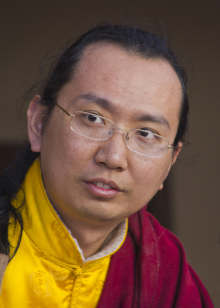Sakya Trizin

Sakya Trizin (T. sa skya khri 'dzin ས་སྐྱ་ཁྲི་འཛིན།; "Sakya Throne-Holder") is the traditional title of the head of the Sakya school of Tibetan Buddhism.[1]
The Sakya school was founded in 1073 CE,[2] when Khön Könchog Gyalpo, a member of Tibet’s noble Khön family, established a monastery in the region of Sakya, Tibet, which became the headquarters of the Sakya order.[3] Since that time, its leadership has descended within the Khön family.
The 41st Sakya Trizin, whose reign spanned more than fifty years, was the longest reigning Sakya Trizin.[4] The current Sakya Trizin is the 42nd Sakya Trizin Ratna Vajra Rinpoche.[5]
Succession System
On 11 December 2014, a new throne holder succession system was announced during the 23rd Great Sakya Mönlam prayer festival on a resolution passed by the Dolma Phodrang and Phuntsok Phodrang, where members of both Phodrang will serve the role of Sakya Trizin in one three year term, according to their seniority and qualification.[6]
Ratna Vajra Rinpoche was enthroned on 9th March 2017 as the 42nd Sakya Trizin, the first to be enthroned under the new system.[5]
Footnotes
- ↑ Holy Biographies of the Great Founders of the Glorious Sakya Order, translated by Venerable Lama Kalsang Gyaltsen, Ani Kunga Chodron and Victoria Huckenpahler. Published by Sakya Phuntsok Ling Publications, Silver Spring MD. June 2000.
- ↑ http://tibet.net/about-tibet/glimpses-on-history-of-tibet/
- ↑ The History of the Sakya Tradition, by Chogay Trichen. Manchester Free Press, U.K. 1983.
- ↑ shttp://www.hhthesakyatrizin.org/currentnews_jubilee.html
- ↑ 5.0 5.1 http://www.rigpawiki.org/index.php?title=Kyabgon_Gongma_Trizin_Rinpoche
- ↑ http://sakyatrizinenthronement.org/
References
- Penny-Dimri, Sandra. (1995). "The Lineage of His Holiness Sakya Trizin Ngawang Kunga." The Tibet Journal. Vol. XX, No. 4 Winter 1995, pp. 64–92.
- Trizin, Sakya. Parting from the Four Attachments. Shang Shung Publications, 1999.
External links
| This article includes content from Sakya Trizin on Wikipedia (view authors). License under CC BY-SA 3.0. |